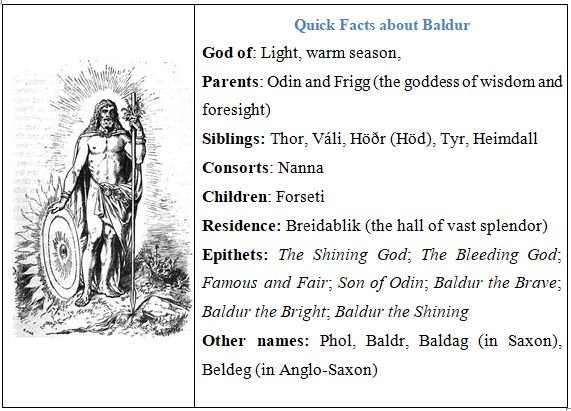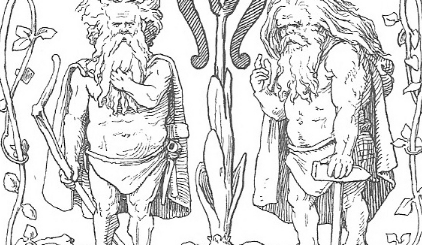Norse God Baldur – Birth Story, Abilities, Symbols, & Death

Baldur myths
Baldur was the Norse god of light and the most beloved of the Aesir gods. Aside from his infectious smile, boundless wisdom and kindness, he is most known for dying from a mischievous trick cooked up by Loki, the trickster god in Norse mythology.
Baldur’s name generally inspires a sense of bravery, happiness, and light in Norse mythology. What else is Baldur known for? And how was he killed?
Worldhistoryedu.com presents to you Norse myths surrounding the birth, powers, and death of Baldur, the most beautiful and brightest of the gods.
Meaning of his name
His name can be interpreted into ‘courageous and defiant’ or ‘hero/prince’; Baldur’s name in Old Norse actually means ‘mighty man’. In old English, it was interpreted as ‘confident’ or ‘frank’. Those translations further reinforce Baldur’s character as one of upstanding and honest in nature.
Over the centuries, Baldur’s name has been consistently associated with positive attributes such as light, strength, and honor.
Baldur’s family
Baldur was the son of the Odin (the king of the gods) and Frigg (queen of the gods). His older brother was Thor, the hammer-wielding god of thunder. His other siblings included the likes of Váli, Heimdall and Höðr (Höd). Baldur married Nanna, the daughter of Nep. Together the two deities gave birth to Forseti, the god of justice and peace.
Read More: 10 Major Norse Gods and Goddesses
Baldur’s traits and powers

Baldur – the Norse god of light, happiness and warm season
According to Gylfaginning, Baldur is the second son of Odin, coming in behind Thor. He is also described as being the best of the gods and as such all manner of good things must be said about him. The prose goes on to say that Baldur is fair, just and bright. In fact, such was his bright nature that light came out of him.
Baldur is often considered the wisest among the Æsir gods. He is meek in his ways, and he often spoke with a tender and gracious voice. His dwelling place – Breidablik – is believed to be the cleanest and the most virtuous part of the heaven.
It was believed that Baldur’s hall, Briedablik, was the most beautiful and elegant of halls in all the Nine Realms.
Other powers and abilities that Baldur possessed include vast wisdom and knowledge, prophetic abilities, precognition, invulnerability, love manipulation, and immense charisma. It was also believed that Baldur served as the arbiter of conflicts among gods and men.
How did Baldur die?
In addition to being known for his flawless character, Baldur is often famous for his tragic death. These stories were mainly compiled in 13th century Iceland from Old Norse poetry. Additionally, the Poetic Edda and the Prose Edda make mention of Baldur’s death.
Baldur’s death was a huge turning point in the lives of the gods, as it brought forth untold chaos throughout the Nine Realms. According to the prophecy, Baldur’s death is a precursor to Ragnarök – the tragic demise of the gods and the Nine Realms. How then did Baldur die?
Prior to his death, Baldur is believed to have had visions of his own death. His mother – the goddess Frigg – is also believed to have seen similar visions in her dreams. However, because Frigg swore never to reveal events of the future, she remained tight-lipped about Baldur’s impeding demise.
Frigg tried to protect her son by visiting every animate and inanimate object in the world. She made them vow never to harm her son Baldur. However, she failed to consult with the mistletoe, thinking of the plant as unintimidating and not important.
The god of mischief Loki exploited the situation by using his magic to fashion out an arrow from the mistletoe. He then proceeded to present the arrow to Höðr – Baldur’s blind brother. Not thinking anything of the arrow, Höðr shot the arrow straight at Baldur, killing him on the spot.
Burial of Baldur and the onset of Ragnarök

Burial of Baldur | Odin whispering his last words to Baldur | Image by W. G. Collingwood (1908)
The body of Baldur was placed in his ship – Hringhorni (the mightiest ship in the realm) – and then later burnt. For reasons unknown, Baldur’s brother, Odin, pushed Litr the dwarf into the burning ship.
Grief struck, Baldur’s wife, Nanna, jumped into the funeral fire hoping to be reborn and reunited with Baldur after the events of Ragnarök. The gods also threw all of Baldur’s belongings into the fire, including his horse. As the ship that carried Baldur’s burning moved away, the earth trembled violently.
Shortly after the death of Baldur, one of the gods, Hermod, was dispatched to the underworld to secure Baldur’s release. Hel, the ruler of the underworld, promised to release Baldur provided every object in the world wept for the dead god. With the exclusion of the giantess Þökk (Thökk), all the objects wept for Baldur. It turned out that Loki had disguised himself as Þökk. As a result of this, the gods were not able to meet Hel’s conditions. Baldur was therefore not released.
There was a prophecy that stated that Baldur would emerge in all his glory and form after Ragnarök; thus he would be reborn and take his rightful place as ruler of the new world alongside his brother Höðr.
The Imprisonment of Loki

Loki was punished by the gods for his involvement in the death of Baldur | Image: The Punishment of Loki by Louis Huard
As punishment for his crimes against the gods and Baldur, Loki was caught and chained to three massive rocks. The gods then placed a venomous serpent above his face. With every drop of the serpent’s venom, Loki had to endure agonizing pain. Loki’s sentence was expected to last until Ragnarök begins.
Other interesting myths about Baldur

Baldr in an illustration to a Swedish translation of the Elder Edda.
- During a very heated flyting (quarrel) between Loki and the gods in the Aegir’s hall, Loki confessed to being responsible for the death of Baldur.
- Baldur constructed the mightiest and largest ship in all the known worlds. The ship was called Hringhorni (Ringhorn).
- Like many stories about Norse gods, much of what we know about the Norse god Baldur comes from a collection of Old Norse poetry, the Prose Edda, and Snorri Sturuluson’s Prose Edda titled Gylfaginning.
- According to an old Danish story, Baldur and Høtherus hand to fight each other for the hand of Princess Nanna, the daughter of Gewer (King of Norway). In spite of receiving support from Thor and Odin, Baldur lost the fight, allowing Høtherus to marry Nanna.
- After the death of Baldur, Odin and Rindr went on to give birth to Váli. It is believed that Váli later killed Höðr.
- The famous Poetic Edda poem Völuspá states that Baldur does not remain dead forever; rather, he is reborn after the passage of Ragnarök.
- In another story, Baldur was not killed by Höðr; instead, he fell to the mistletoe-fashioned sword of Høtherus.
- Some stories claim that the reason why Frigg forgot to ask the mistletoe to not harm Baldur was because she considered it too young to take an oath.



























